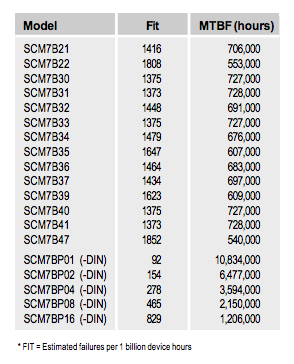an704: Failure Rate Calculation and Prediction
Application Note
Failure rate calculations for the SCM7B modules are derived from 1.) the MILHDBK-217
(Reliability Prediction of Electronic Equipment), and 2.) Demonstrated
Performance.
In addition, Dataforths quality system includes an ongoing SCM7B reliability program which continuously generates accelerated life test data for reliability prediction. The reliability prediction model used is based upon the exponential failure rate, which assumes constant failure rate in time and no failure mechanism change between stress and use conditions. The Chi-squared prediction method is used to qualify this assumption (using actual data for the Bartlett statistic), as indicated by the confidence level. Coupled with the Arrhenius temperature equation (using 1eV activation energy), temperature derating is performed to determine the MTBF and FIT at various operating temperatures.

MIL-HDBK-217 RELIABILITY PREDICTION
The Part Stress Analysis method was used at a ground benign environment, +35°C temperature, and quality level B-2 to D-1 depending on component. The failure rates presented apply to modules under normal operating conditions.DEMONSTRATED RELIABILITY
All SCM7Bs undergo a 48 hour powered and under bias burn-in at +85°C before final calibration and shipment. This preconditioning serves to minimize field failures by stabilizing components and causing infant failures, if any, to occur.In addition, Dataforths quality system includes an ongoing SCM7B reliability program which continuously generates accelerated life test data for reliability prediction. The reliability prediction model used is based upon the exponential failure rate, which assumes constant failure rate in time and no failure mechanism change between stress and use conditions. The Chi-squared prediction method is used to qualify this assumption (using actual data for the Bartlett statistic), as indicated by the confidence level. Coupled with the Arrhenius temperature equation (using 1eV activation energy), temperature derating is performed to determine the MTBF and FIT at various operating temperatures.

Was this content helpful?
Thank you for your feedback!






